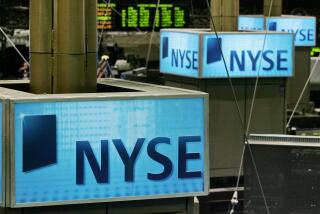Stocks Betting Profit Peak Remains Far Off
As if there was ever any doubt, stock market action last week demonstrated that corporate earnings growth really does drive share prices.
The Dow industrial average zoomed to new heights by Friday on the heels of spectacular first-quarter earnings reports from companies such as IBM Corp., Eastman Kodak Co. and Coca-Cola Co.
Despite three months of government data pointing conclusively to slower U.S. economic growth, that weakness hasn’t been reflected on many companies’ bottom lines. Investors, clearly surprised by Corporate America’s resilience, have responded by rethinking what stocks are worth.
But rising share prices probably say more about the rest of the year--and 1996--than about the first quarter, some analysts say.
Wall Street doesn’t bid up stocks based on ancient history, which is what the first quarter has already become. Rather, investors price stocks on expectations. And those expectations have plainly been shifting as far as corporate earnings are concerned.
First-quarter results are suggesting that 1995 earnings overall will be stronger than expected. Perhaps more important, Wall Street is reassessing earnings growth potential in 1996, and finding many more reasons to be bullish.
Abby J. Cohen, investment strategist at brokerage Goldman, Sachs & Co. in New York, notes that investors’ traditional obsession at this point in the economic cycle is with peak earnings--in absolute terms and in terms of year-to-year percentage change.
If you assume that a company will earn $4 a share this year, but only $3 a share next year, you probably won’t pay up for the stock. Likewise, if you expect a company’s earnings to be up 15% this year over 1994, but only up 5% in 1996 versus 1995, you may ratchet down the share price you’re willing to pay.
What may be occurring now is that investors are changing both sets of assumptions--moving peak earnings expectations to 1996 from 1995 for some companies, and raising 1995 and 1996 percentage growth estimates for others.
Cohen believes that shift is logical given her forecast of continued, albeit slower, economic growth. “Is this (the first quarter) the peak in year-over-year percentage earnings gains? Maybe. But will earnings now start declining? No way,” she says, referring to corporate profits overall.
And for the stock market’s purposes, “There’s a difference between earnings growing at a less rapid pace and earnings declining,” Cohen says.
First-quarter profit reports obviously provide plenty of support for earnings bulls like Cohen.
“It’s a very strong quarter,” says John Eliseo, analyst at earnings-tracker IBES in New York. So far, 1,400 U.S. companies have reported results, about 40% of the universe of firms followed by IBES.
Fifty-eight percent of the 1,400 companies have beaten analysts’ earnings expectations, while only 27% have fallen below estimates, Eliseo says. The typical company has earned 5% more than expected, and the average gain in first-quarter operating earnings (that is, results excluding one-time gains or write-offs) is 26% over first-quarter 1994 results.
To put that in perspective, consider: U.S. corporate operating earnings grew 16.5% in 1994 over 1993, averaging results for all IBES-tracked companies.
How could first-quarter earnings be so healthy in a downshifting economy? Many companies say that despite some softening in U.S. demand, foreign demand remains robust. The weak dollar also helped U.S. exporters, not only in reducing the prices of their goods but in magnifying foreign earnings when repatriated into dollars.
More significant for many American companies, though, is the continuation of two powerful trends that have come to define the 1990s. One is the ongoing emphasis on boosting productivity and reducing costs.
“All of those corporate restructuring efforts of the last few years are finally starting to hit the bottom line,” says James Craig, manager of the Janus Fund stock mutual fund in Denver.
Case in point: Illinois Tool Works, a Glenview, Ill.-based maker of a vast array of parts for heavy industry and the construction business. It reported a 47% jump in first-quarter earnings on a 20% sales rise, to $929 million.
After years of cost cutting, “For us to increase our bottom line we don’t need a real strong economy,” says Michael Gregg, ITW senior vice president. Continually improving productivity is “like peeling an onion,” he says. “With every layer (of costs) you take off, you see another.”
Second, analysts note that business spending on technology and capital equipment remains robust worldwide, which is a great benefit to U.S. companies, which are leaders in both fields.
Indeed, the Assn. for Manufacturing Technology reported Sunday that orders for U.S.-built machine tools totaled $1.32 billion in the first quarter, the highest level in almost 15 years and 31% above the same period a year ago.
What worries some analysts, however, is that while machine tool builders and a host of other U.S. firms were filling orders in the first quarter, unsold inventories of finished goods also were piling up--largely a reflection of slower consumer spending, which still accounts for two-thirds of U.S. economic activity.
“In the first two months of this year, (inventory) accumulation at manufacturers and wholesalers was nearly 20% greater than in the final three months of 1994,” says Stephen Roach, economist at Morgan Stanley & Co. in New York.
Hence, he expects industrial production to be significantly reduced over the next six months as manufacturers wait for goods already in inventory to be sold. That will provide the acid test for corporate profits, Roach says. “My fear is that the first quarter really caps the earnings surge,” he says.
Still, Roach is forecasting a slowing economy--not a shrinking one. So the question isn’t whether many U.S. companies can continue to post rising earnings, but how large those earnings gains can be.
Wall Street, in pushing stocks higher despite the universal sense that the U.S. economy’s pace will slacken this year, seems to be siding with Abby Cohen’s view: Corporate earnings growth may slow from this point, but the numbers in 1995 and in 1996 still will be impressive, thanks to foreign sales, modest price increases and additional productivity gains.
IBES says analysts’ estimates currently point to an 18.5% average rise in corporate operating earnings this year versus 1994. Typically, estimates come down as the year progresses and analysts make adjustments, IBES’ Eliseo says. If estimates are cut as usual, he says 1995 earnings should end up being 12% to 13% above 1994 results--a healthy increase by any measure.
For 1996, analysts’ average estimated gain for U.S. companies currently is 14.6%, Eliseo says. Again, that is probably too optimistic. But the point is, the trend of earnings still is up. And assuming interest rates and inflation stay under control, rising earnings provide the basic support needed to maintain a bull market in stocks.
More to Read
Inside the business of entertainment
The Wide Shot brings you news, analysis and insights on everything from streaming wars to production — and what it all means for the future.
You may occasionally receive promotional content from the Los Angeles Times.










